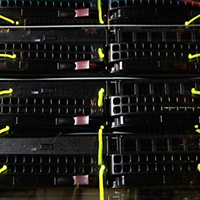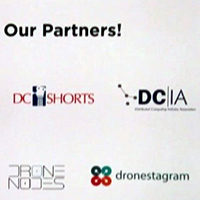In This Issue
- Hack Has Biz Uneasy
- Usefulness Outlived
- Talent Competition
- Report from the CEO
- Pentagon Aims High
- Moving Cloud Closer
- Value of Fog & Edge
- Telecom Cloud Market
- Open Fog Consortium
- Edge Interoperability
- When Disasters Strike
- Edge for IoT Efficiency
- Big Data Ent Solution
- Senate Panel on FTC
- 5G, IoT, Embedded AI
- GLTS Returns to GVE
- Coming DCIA Events
Equifax Hack Has Businesses Uneasy
Excerpted from AP News Report by Joyce Rosenberg
 The Equifax breach is reminding small business owners that they may be vulnerable to cybercriminals.
The Equifax breach is reminding small business owners that they may be vulnerable to cybercriminals.
Companies that provide security and other technology services to small businesses say they’ve had an increase in calls from customers since Equifax revealed that the personal information of 145.5 million Americans had been exposed.
The hack galvanized some owners into dealing with long-delayed issues.
“A customer called me today wanting to replace their one remaining XP computer,” says Bob Herman, owner of IT Tropolis, a tech service company in Fountain Valley, CA.
Microsoft stopped providing security updates for XP models three and a half years ago.
Small businesses often lag behind big companies in data security, not believing they might be targets.
But 61 percent of the victims of breaches in 2016 were businesses with fewer than 1,000 employees, according to a Verizon survey.
And experts say small companies are being targeted more because they don’t have the sophisticated defenses that big corporations do… Read More
Social Security Numbers Outlived Usefulness
Excerpted from FOXBusiness Report by Brittany DeLea
 The Equifax breach of 145.5 million Americans’ personally identifiable information has brought cybersecurity to the national forefront and as experts grapple with protecting consumer privacy, the Social Security number could be on the chopping block.
The Equifax breach of 145.5 million Americans’ personally identifiable information has brought cybersecurity to the national forefront and as experts grapple with protecting consumer privacy, the Social Security number could be on the chopping block.
“I feel very strongly that the Social Security number’s outlived its usefulness,” Rob Joyce, White House Cybersecurity Coordinator, said during a Washington Post conference on Monday.
“It’s a flawed system.”
“If you think about it, every time we use the Social Security number, we put it at risk.”
A Social Security number is a personal identifier that connects an individual to all sorts of information online.
These numbers were just one of the many pieces of personal data compromised when unauthorized third parties accessed information at Equifax earlier this year.
However, as Joyce pointed out, a person cannot roll back the risk to her Social Security number once it has been breached… Read More
SEC Faces Tough Competition for Cybersecurity Talent
Excerpted from Report by CIO Journal Report by Angus Loten
 The Securities and Exchange Commission (SEC) on Tuesday announced plans to ramp up cybersecurity, following revelations earlier this month that hackers had accessed data for illegal trades.
The Securities and Exchange Commission (SEC) on Tuesday announced plans to ramp up cybersecurity, following revelations earlier this month that hackers had accessed data for illegal trades.
SEC Chairman Jay Clayton told a Senate Committee this week the efforts will include hiring more cybersecurity talent, saying “single actors dwarf the amount that we have available to spend in this area.”
As the Wall Street Journal reports, finding and recruiting these new workers won’t be easy.
“There’s a talent shortage and it’s even more emphasized at the federal level,” Rick Holgate, a research director at Gartner, told CIO Journal.
He said high-profile breaches in the private sector, such as Equifax, are boosting demand — and compensation — for cybersecurity experts across the economy, increasing the pressure on an already tight labor market.
By one estimation, unfilled jobs are expected to number 1.8 million by 2022, up 20% from 1.5 million in 2015, according to a global survey of 19,000 cybersecurity workers by the nonprofit Center for Cyber Safety and Education, CIO Journal reported in May. A key barrier for public-sector recruiters is compensation… Read More
Report from DCIA CEO Marty Lafferty

In the wake of the horrific Las Vegas, NV shooting tragedy, it should be incumbent upon leaders of every industrial sector to examine potential solutions their participating members responsively could offer to improve physical security of the public at large.
The distributed computing industry may be positioned to offer more assistance than one at first would imagine.
Most observers would agree that applications being developed and deployed in smart buildings, smart cities, and smart public environments hold promise to provide earlier and better warnings of imminent danger to law enforcement and affected populations alike.
But two other emerging growth areas may be able to provide even more valuable before-the-fact benefits — internet of things (IoT) and big data — appealing both to those who would base responsive actions purely on logic and to those whose emotions are driving their views of steps that should be taken to reduce threats.
A basic IoT approach, for example, might require that monitoring sensors be embedded within all firearms in private sector distribution.
Such chipsets could detect whether or not a weapon is loaded and if so with what ammunition and — as importantly — track and report its physical location in real-time.
Analytics could be applied to so generated IoT data with certain results — such as multiple weapons being transported to a hotel room overlooking a heavily attended event — triggering immediate alarms to local officials.
Algorithms for discerning suspicious patterns of activity would improve in the fullness of time making such an IoT and big data approach more and more beneficial.
Newly manufactured firearms could be equipped initially, followed by a mandatory recall period for retrofitting existing weaponry, after which non-compliant guns could be subject to confiscation and their bearers subject to fines and/or imprisonment.
The National Rifle Association (NRA) could be tasked with helping to communicate and implement the program; with appropriate incentives and penalties applied to manufacturers, distributors, and owners based on participation.
Finally, adapting another distributed computing industry technology that is becoming increasingly commonplace in the mobile cloud space, firearms also could be equipped with authorized-bearer two-factor authentication, such as fingerprints and alphanumeric codes, in order for them to be rendered operable.
In short, technologies are available that would improve the physical security of both gun owners and the public at large, grow more and more effective over time, and not impede personal freedoms currently enjoyed by consumers. Share wisely, and take care.
Pentagon Aims High in Cloud Adoption Strategy
Excerpted from Bloomberg Report by Laura Criste
 The US Department of Defense (DoD) will follow Silicon Valley’s lead and emphasize cloud computing as it seeks to secure sensitive databases and preserve the technological advantage the US military enjoys around the world.
The US Department of Defense (DoD) will follow Silicon Valley’s lead and emphasize cloud computing as it seeks to secure sensitive databases and preserve the technological advantage the US military enjoys around the world.
Deputy Secretary Patrick Shanahan emphasized the need to prioritize cloud usage in a memo following Defense Secretary James Mattis visited Seattle, WA and Palo Alto, CA, and saw how commercial entities are protecting themselves against cyberattacks.
Shanahan stressed that innovative technologies are both rapidly evolving and altering war, making IT modernization essential to maintaining the US military advantage.
He wants to speed up the Pentagon’s adoption of cloud computing to promote risk-taking, provide the latest technologies to warfighters, and accelerate IT procurement and development.
One of the most important activities that resulted from the memo is the establishment of a Cloud Executive Steering Group (CESG) to devise and oversee the adoption strategy with a focus on commercial solutions.
Shanahan also outlined what he calls the “cloud adoption initiative” in two phases… Read More
Moving the Cloud Closer to Business
Excerpted from Report by Andrew Froehlich
 We will soon reach the point where connectivity to cloud resources is going to become a serious issue in terms of real-time computing functions.
We will soon reach the point where connectivity to cloud resources is going to become a serious issue in terms of real-time computing functions.
So, how do we bring the cloud closer to us?
Having all the data in the world is worthless if we can’t quickly access and analyze it in real-time.
The advent of cloud computing has solved many enterprise IT challenges in the wake of the digitization of the business landscape.
Cloud elasticity, scalability and security allow organizations to accomplish things never thought possible, thanks to the elimination of massive up-front infrastructure costs.
This has led to big data analytics, the internet of things (IoT) and artificial intelligence (AI), among other new business practices.
Yet with all the advancements inside the cloud, it leaves many of us with one final problem — connectivity to the cloud… Read More
The Value of Fog & Edge Computing
Excerpted from CIO Report by Perry Lea
 The IoT is an exciting topic as businesses across all industries make plans to incorporate smart devices and sensors into their business models.
The IoT is an exciting topic as businesses across all industries make plans to incorporate smart devices and sensors into their business models.
Because of this, each year the amount of data generated globally continues to grow.
The problem with this scenario is that total worldwide data generation is growing faster than total worldwide network capacity.
We can’t move all the data to the cloud – we must push intelligence down toward the source of the data.
In the coming years, we will need to move data before it hits the cloud.
Fog and Edge Computing offer a solution to the swelling data dilemma by bringing processors to where the data is located, not moving data to where the processors are.
Cloud computing, like Software-as-a-Service (SaaS), Infrastructure-as-a-Service (IaaS), and Platform-as-a-Service (PaaS), provides standard interfaces and methodology to deploying solutions in the cloud… Read More
Telecom Cloud Market 2017-2022
Excerpted from TradeCalls Report by Kim Swaby
 Global Telecom Cloud Market Size, Status and Forecast 2017 to 2022 provides a unique tool for evaluating the market, highlighting opportunities, and supporting strategic and tactical decision-making.
Global Telecom Cloud Market Size, Status and Forecast 2017 to 2022 provides a unique tool for evaluating the market, highlighting opportunities, and supporting strategic and tactical decision-making.
This report recognizes that in this rapidly-evolving and competitive environment, up-to-date marketing information is essential to monitor performance and make critical decisions for growth and profitability.
It provides information on trends and developments, and focuses on markets and materials, capacities and technologies, and on the changing structure of the telecom cloud market.
Companies mentioned are AT&T, BT Group, CenturyLink, China Telecommunication Corporation, Deutsche Telekom, Fusion Telecommunications International, Huawei Technologies, International Business Machines (IBM), Level 3 Communications, NTT Communications, Orange Business Services, Singapore Telecommunications, TATA Communications, Telefonica, Telefonaktiebolaget LM Ericsson, Telstra Corporation, Telus Corporation, Verizon Communications, and Vodafone Group, ZTE Corporation.
The global telecom cloud market consists of different international, regional, and local vendors… Read More
OpenFog Consortium Welcomes Carrier Input
Excerpted from FierceWireless Report by Monica Alleven
 The head of the OpenFog Consortium wants wireless operators to know they’re welcome to join a diverse group of people to validate or help shape their assumptions about fog computing.
The head of the OpenFog Consortium wants wireless operators to know they’re welcome to join a diverse group of people to validate or help shape their assumptions about fog computing.
There are a lot of “open” groups out there and OpenFog is a relatively new and growing one, but it would like to see more carrier involvement.
“It’s a tremendous opportunity for them operators to actually come in and work with a diverse group of perspectives and perhaps validate some of their assumptions or help shape some of their assumptions,” said Helder Antunes, Chairman of the OpenFog Consortium and Senior Director for the Corporate Strategic Innovation Group at Cisco.
“This is a tremendous opportunity to come and join us and help us define what this looks like.”
The consortium was an idea that Antunes had along with Professor Mung Chiang of Princeton at the time, who is now the Dean of Purdue’s School of Engineering, and Dr. Tao Zhang, a Cisco Distinguished Engineer and IEEE Fellow.
They decided they needed a more horizontal organization to tackle the issues of the day.
“We thought someone needed to come and put together a group that would sort of look at the whole thing horizontally… Read More
Edge Computing Groups Wrestle with Interoperability
Excerpted from Light Reading Report by Iain Morris
 Interoperability has emerged as a huge concern for the different industry groups working on standardized approaches to edge computing.
Interoperability has emerged as a huge concern for the different industry groups working on standardized approaches to edge computing.
The proliferation of groups tackling the edge-computing challenge has exacerbated concern about fragmentation and the risk that incompatible technologies and techniques begin to appear.
Standards group European Telecommunications Standards Institute (ETSI) and an industry association called the OpenFog Consortium this week said they would collaborate on defining the application programming interfaces that will link computing assets to the applications that need to use them.
But as alternative groups such as the Open Networking Foundation, Open Edge Computing and the Telecom Infra Project (TIP) also eye roles in the edge computing drama, industry executives have voiced some anxiety.
“There is more work that needs to be done on interoperability testing between these different systems,” said Steve Vandris, the board director of the OpenFog Consortium and a director of IoT and 5G solutions in Intel’s datacenter network solutions group, during this week’s MEC World Congress in Berlin… Read More
When Disasters Strike, Edge Computing Must Kick-In
Excerpted from Network World Report by Patrick Nelson
 Edge computing and fog networks must be programmed to kick-in when the internet fails during disasters, a scientific research team says.
Edge computing and fog networks must be programmed to kick-in when the internet fails during disasters, a scientific research team says.
That way, emergency managers can draw on impacted civilians’ location data, social networking images, and tweets and use them to gain situational awareness of scenes.
Routers, mobile phones, and other devices should continue to collect social sensor data during these events, but instead of first attempting to send it through to traditional cloud-based depositories operated by the social network – which are unavailable due to the outage – the geo-distributed devices should divert the data to local edge computing, fog nodes and other hardened resources.
Emergency officials can then access it.
It’s “a new way of gathering and sharing information during natural disasters that does not rely on the internet,” says the Georgia Institute of Technology.
“Using computing power built into mobile phones, routers, and other hardware to create a network… Read More
Edge Computing for IoT Efficiency
Excerpted from IoT Evolution Report by Julia Sowells
 Managing IoT devices can be very tough.
Managing IoT devices can be very tough.
Chiefly because they sometimes depend heavily on quick data processing.
For this to happen, the data centers or servers responsible for processing the IoT device data has to be located in close proximity to the IoT device.
This is not possible always.
Therefore to avoid this problem and improve the network’s efficiency (as well as security) so that IoT data is processed as quickly as possible, administrators these days are making use of what is being termed as Edge Computing.
Edge computing is the process of designing the IT network infrastructure such that the data emerging out of various IoT devices get processed as close to them as possible in order to increase the response time.
Edge computing, apart from improving the network efficiency, also plays a major role in decreasing the cost of computer components… Read More
Big Data Solution in Enterprises
Excerpted from CIOReview Report by Advait Kulkarni
 Data is the most valuable currency in today’s digital era.
Data is the most valuable currency in today’s digital era.
Whether it is trying to gather information about internal operational process metrics, collecting customer satisfaction scores or getting insights into the sales and marketing effectiveness, data is of prime importance.
This is then used to implement continuous improvement and predictive planning to improve customer satisfaction, quickly inform big decisions, eliminate waste and reduce risk in different areas.
Since this collection of data sets or information has too large and complex to be processed by standard tools, Big Data is the art and science of combining various changing enterprise, social and machine data to derive new insights.
The biggest and the early entrant in the Big Data space is the Hadoop infrastructure.
To make indexing of the immense amount of data generated by the web possible, Google created the MapReduce style of processing. MapReduce programming uses two functions, a map job that converts a data set into key/value pairs, and a reduce job that combines the outputs of the map job into a single result.
This approach to problem solving was then adopted by developers who were working on Apache’s “Nutch” web-crawler project… Read More
Senate Panel Reviews FTC Data Security Enforcement Powers
Excerpted from Bloomberg Report by Jimmy Koo
 The recent Equifax data breach prompted senators at a September 26th hearing to question whether the FTC has the proper authority to effectively enforce data security standards.
The recent Equifax data breach prompted senators at a September 26th hearing to question whether the FTC has the proper authority to effectively enforce data security standards.
How to better define the Federal Trade Commission’s authority to oversee corporate data security is a long-standing issue, and U.S. credit bureau Equifax’s breach compromising the personal data of 143 million consumers has, at least for the moment, further raised interest in the subject.
The Senate Commerce Subcommittee on Consumer Protection, Product Safety, Insurance, and Data Security heard testimony on proposals to improve the FTC’s handling of consumer protection issues, including its role in overseeing data security efforts. Subcommittee Chairman Jerry Moran (R-KS) said that there will be a full committee hearing on the Equifax data breach in “mid-October.”
Subcommittee Ranking Member Senator Richard Blumenthal (D-CT) said that he will soon introduce legislation to allow the FTC to investigate any data breaches, exercise oversight, and issue penalties.
Companies under the FTC’s jurisdiction-from internet giants Amazon and Facebook to smaller businesses… Read More
Future of 5G, IoT, and Embedded AI
Excerpted from Fog World Congress Press Announcement
 The OpenFog Consortium (OpenFog) and the IEEE Communications Society (IEEE ComSoc), today introduced Fog World Congress, the first multi-day conference and exhibit on fog computing and networking.
The OpenFog Consortium (OpenFog) and the IEEE Communications Society (IEEE ComSoc), today introduced Fog World Congress, the first multi-day conference and exhibit on fog computing and networking.
The event will take place on October 30th and November 1st at the Santa Clara, CA Marriott.
The conference features more than 75 speakers, 55 sessions and an exhibit area to showcase the technologies, applications and research enabling new business models in the Internet of Things (IoT), 5G and embedded artificial intelligence (AI).
Fog computing enables rapid, secure processing of critical data-dense applications, addressing inherent challenges that neither cloud nor edge can resolve alone.
Fog distributes computing, storage, control and networking services, enabling real-time data analytics, supporting time-critical local control, connecting and protecting vast and diverse resource-constrained devices, and overcoming network bandwidth and availability constraints.
“Supporting complex, emerging systems and applications, such as the IoT, 5G mobile systems, embedded AI… Read More
GLTS Returns to GV Expo
Register Today for Your Free Pass to Attend
 Join us on November 29th and 30th at the 2017 Government Video Exposition (GV Expo) as event host NewBay Media works with the team at the Federal Government Distant Learning Association to bring you the Government Learning Technology Symposium.
Join us on November 29th and 30th at the 2017 Government Video Exposition (GV Expo) as event host NewBay Media works with the team at the Federal Government Distant Learning Association to bring you the Government Learning Technology Symposium.
Last year’s inaugural GLTS was a rousing success, bringing together the growing community of distance learning professionals in the Federal Government.
Attendees came from all parts of the military and civilian agencies, corporate partners, and many affiliated organizations.
This event provided attendees with a chance to gain insights into the latest in media technologies for government users.
NewBay is working with industry leaders focused on making sure you leave with tangible knowledge to help you reach your goals.
Here are a few speaker highlights: Dr. J. Richard Kiper, Special Agent, Federal Bureau of Investigations US Department of Justice… Read More
Coming Events of Interest
2017 Storage Visions Conference — October 16th in Milpitas, CA. “New Visions for Digital Storage” will bring together the vendors, end-users, researchers, and visionaries who will meet the growing demand for digital storage for all aspects of unstructured and lightly structured data.
Mobility Unmanned — November 1st and 2nd in Washington, DC. Providing key stakeholders the unique opportunity to explore cutting-edge autonomous technology and examine the emerging regulatory landscape governing the commercial use of unmanned vehicles in all sectors – air, land, and sea.
Industrial Internet of Things (IoT) Europe — November 7th and 8th in Munich, Germany. IoT Europe will bring together forward-thinking companies from the manufacturing, energy, and transportation sectors to pave the way for the Industrial IoT revolution.
Government Video Expo & National Drone Show — November 28th-30th in Washington, DC. The 22nd annual GVE will feature a full exhibit floor with numerous training options, free seminars, keynotes, networking opportunities, and five new educational pavilions.
CES — January 9th through 12th in Las Vegas, NV. Organized by the Consumer Technology Association, this large annual event typically hosts presentations of new products and technologies in the consumer electronics industry.
Delivery of Things World 2018 — April 23rd and 24th in Berlin, Germany. Meet the most influential DevOps practitioners and experts and discuss what DevOps means for your business.
